After a brief but magical interlude in the isolated Cadiz Dunes in the Mojave, my partner Leslie and I continued our February survey of the southwestern deserts by heading to Nevada.
From our campsite on the edge of the dune field, we retraced the sandy 5-mile spur that had brought us there, and turned north on unpaved Cadiz Road for the 15-mile slog to the town of Amboy. This phase of the trek took nearly as long as the 30-mile reach of Cadiz Road we’d crossed the previous day owing to its prodigiously more rocky and rutted surface.
Our most direct route to our next destination would have then taken us east along historic Route 66 — officially known as the National Trails Highway — but that section is closed for the next year or so while crews replace all of its scores of timber bridges. Most were built nearly a century ago, and they have been deemed too decrepit to support traffic any longer thanks to age and flash floods.
So, for those of you following along on the map at home, we backtracked west, picked up Interstate 40 and headed east toward Needles. Just outside of town, we jogged north on U.S. 95, crossed the Nevada line and picked up State Route 163 east toward Laughlin. After a few miles, we turned off onto an unpaved route with the delightfully bonkers name of Christmas Tree Canyon Road. That led us into Avi Kwa Ame National Monument and Grapevine Canyon, our destination.
The monument’s name (pronounced Ah-VEE kwa-meh) translates to “Spirit Mountain” in the language of the Indigenous Mojave people, and refers to the peak (the highest summit in the Newberry Mountains) that looms above Grapevine Canyon. Established by President Biden in March 2023, the monument encompasses more than 500,000 acres, including lands regarded as sacred or spiritually significant by a dozen Indigenous cultures throughout the Southwest. These include the Chemehuevi, Southern Paiute, Cocopah, Halchidhoma, Havasupai, Hopi, Hualapai, Kumeyaay, Maricopa, Pai Pai, Quechan, Yavapai and Zuni.
In the cosmogenic myth of several of these Indigenous peoples, Spirit Mountain and its canyons are the place of creation, the landscape where the world and all that live upon it were made by ancient spirits. One result of all that spiritual power being vested in the mountain and its surroundings is the presence of a striking aggregation of petroglyphs on the boulders framing the entrance to Grapevine Canyon, which appears to provide a sort of physical portal into the mountain’s heart.
It was there, according to a guidebook by archaeologist and rock-art expert David S. Whitley, that tribal shamans would go seeking power-bestowing visions. And it is where they would record on the rocks the images they observed, during states of altered consciousness, of the world’s creation.
It is impossible to be certain that this is what the petroglyphs represent. But Whitley’s theories about the nature of rock art in the far West are based in part on analysis of ethnographic data collected more than a century ago from living practitioners of shamanic tradition. This lends it credence as a counterpoint to the common and simplistic assertion by public-land agencies that we can never have any idea what the rock art under their stewardship represents.
The Grapevine Canyon panels are magnificent, and somewhat resemble those at Corn Springs, which we visited earlier in our trip. Descendants of those who created them live among us, and played a key role in the campaign to secure federal protection for their ancestral homeland. It’s worth listening to what they might tell us about them. And if they don’t wish to share those stories with outsiders, we should respect that, too.
Land of desert fish
Our next and final destinations were the near-ghost-town of Death Valley Junction and the nearby Ash Meadows National Wildlife Refuge, a reclaimed and restored desert oasis. The U.S. Fish and Wildlife Service, which manages Ash Meadows, sometimes refers to it as “the Galapagos of the Mojave Desert” because of its concentration of life forms found nowhere else. Of its 26 endemic species, most are plants and snails. But the list also includes two charismatic fish species — the Devil’s Hole pupfish and the Ash Meadows Amargosa pupfish — that get most of the attention from visitors.
Looking today at the arid landscape of the Mojave and Great Basin deserts of eastern California and western Nevada, it is hard to imagine what this region looked like 10,000 years ago. In that wetter, cooler time, it was a land of huge lakes tied together by the abundantly flowing Mojave, Amargosa and Owens rivers. Somewhere within that vast interconnected web of water there also was a linkage with the Colorado River system, the native home of the ancestral pupfish, which made its way into lakes throughout the Mojave and Great Basin regions and colonized them.
As the climate grew drier in the wake of the Pleistocene ice age, the lakes shrank and the rivers in many places retreated beneath ground, breaking the conduit for movement of aquatic species. Pupfish populations grew isolated in the dwindling waters, and their evolutionary paths began to diverge. Fast forward to today, when the lakes have vanished and the rivers seldom flow above ground, and the relict desert pupfish survive only in a few remnant pools and springs scattered around the desert.
Ash Meadows is a one-of-a-kind oasis in the Mojave, sitting atop a vast limestone aquifer system that channels fossil ice-age groundwater beneath the desert until it hits a fault that forces it to the surface there. More than 50 seeps and upwelling springs send 10,000 gallons a minute into pools and flowing channels of surface water, which support lush groves of ash and mesquite trees, shrubs, meadow and wetland grasses, more than 275 species of resident or migratory birds, and the aforementioned pupfish.
After orienting ourselves in the refuge’s well-designed visitor center, we spent hours driving to the major springs and hiking along the raised boardwalks that provide access to them. Because of its long residence in limestone, the water is rich in calcium carbonate, which gives it a vivid blue-green color that was especially striking against the gray and brown backdrop of the winter-desert landscape.
Devils Hole itself is deliberately not accessible. The entire population of Devils Hole pupfish — as few as 35 in 2013, now rebounded to around 200 thanks in part to a captive breeding program — lives in that single spring, which is technically inside an isolated unit of Death Valley National Park. Thanks to the species’ notoriety, its proximity to extinction, and previous bad behavior by idiots who treated the spring like a public hot tub, it is surrounded by a sort of maximum-security prison in reverse: designed to keep the criminal element out, not in. There’s a place inside the security fencing to stand and look into the spring, but it’s about 20 feet above it, too far away to see inch-long fish at play.
Fun trivia about Devils Hole from the Ash Meadows NWR website:
The water maintains a temperature of 93° (F) all year-round. Professional scuba divers from Death Valley National Park have mapped the depth to 500 feet but the bottom has never been found. Three scuba divers broke through the fence in 1965 and two went missing. There were 44 rescue divers that spent 3 days searching for them but no trace was ever found. An interesting fact about Devils Hole is that within minutes of an earthquake somewhere in the world waves as high as 6 feet tall have occurred in Devils Hole.
There’s better luck with pupfish viewing in the boardwalk-accessible springs, where Leslie even managed to grab video of them chowing down on algae. Breeding males are a bright electric blue, and they busily chase away rivals and court the more drab females.
Land of dreams
When we’d had our fill of pupfish antics, we drove to Death Valley Junction, where we had reserved a room at the Amargosa Opera House and Hotel. In its way, it is also a one-of-a-kind oasis in the Mojave, built out of adobe in 1923 by the Pacific Coast Borax Co. as a combination of hotel for visiting investors and corporate honchos, dormitory for mine workers, and commercial center and community hall for residents. The company moved away in 1928, and private investors turned the complex into a commercial hotel, which it remains today.
Most of it is sealed off, but it offers 16 guest rooms and an eccentric lobby stuffed with desert memorabilia. It also appears to be the only functional commercial structure in town; the nearest restaurant is 8 miles away at a casino in Nevada. The U.S. Census Bureau reported that in 2020 Death Valley Junction had a population of “less than four people.”
We solved the lack-of-eatery problem by parking Next Chapter immediately in front of our room, where it provided perfectly serviceable kitchen and dining facilities. Instead of a 16-mile round-trip drive between showers and dinner, we had a 20-foot walk.
The borax company’s former community hall is now the Amargosa Opera House, and besides Ash Meadows is the primary reason to visit Death Valley Junction. Long abandoned, it got a new lease on life in 1967, when Marta Becket, a New York ballerina and Broadway dancer on hiatus from tour with her one-woman show, was camping in Death Valley with her husband, Thomas Williams. Their trailer got a flat tire, and they limped to a garage in Death Valley Junction, the nearest town. While she was waiting for the flat to be fixed, Marta wandered over to the boarded-up hall and peered inside.
Where others might have seen only a rodent-infested wreck, she saw possibility: a theater of her own, where she could settle down and produce her own shows. Her 2017 obituary in the New York Times described what came next:
She and her husband found that they could rent the building for $45 a month, and set about renovating it. The roof was fixed. Folger’s coffee cans were turned into stage lights. Ms. Becket sewed the curtains and costumes and painted the sets.
Her first performance came early the next year. Attendance for her shows was sparse at first: Sometimes she would look out from the stage at an audience of no one.
After a flash desert flood in 1968 left a foot of mud inside the theater, she had an epiphany during the cleanup: She would paint an audience on its walls, one that was always packed and keep her company when no one else showed up.
Marta performed her ballets and pantomimes on the Opera House stage for 40 years, 50 performances a season, which ran from October to May to avoid the furnace-like heat of summer. Audience sizes varied, but over time she single-handedly turned Death Valley Junction into an unlikely oasis of art, music and culture that drew visitors from around the world to an isolated corner of the Mojave. (Now owned by a nonprofit she established, it continues to host public entertainment events, though not as frequently.)
The front-desk staff at the hotel offers tours of the Opera House daily at 9 a.m. and 6 p.m., and we joined one the evening of our stay, our final night on the road. The building’s bland exterior in no way prepares you for what you find when the guide unlocks the door, leads you inside and flips on the lights.
Every square inch of the theater’s walls and high ceiling are covered with Marta’s painted murals, featuring a dizzying assortment of characters: renaissance royalty; nuns, monks and prostitutes; clowns, knights in armor, mythological beasts, cherubs. It is a dazzling blizzard of colors, rich and bold and bright, and sensory overload is a very real risk. It takes some time for it all to sink in.
As it does, a sense of awe takes over. The Opera House and its modern history is a vivid testament to one woman’s artistic vision, stubbornness, devotion and imagination. In her way, Marta was a shaman who had visions of creation — not creation of the world, but of her future and her place in that world — painted them on the walls and played them out on the stage for half a lifetime. She willed the second chapter of her life into being, and if the physical manifestation of her visions on those adobe walls is not likely to last as long as the pecked-boulder petroglyphs of Corn Springs and Spirit Mountain, it inspired in us a similar measure of respect. There are many kinds of sacred spaces in the vast expanse of the West.





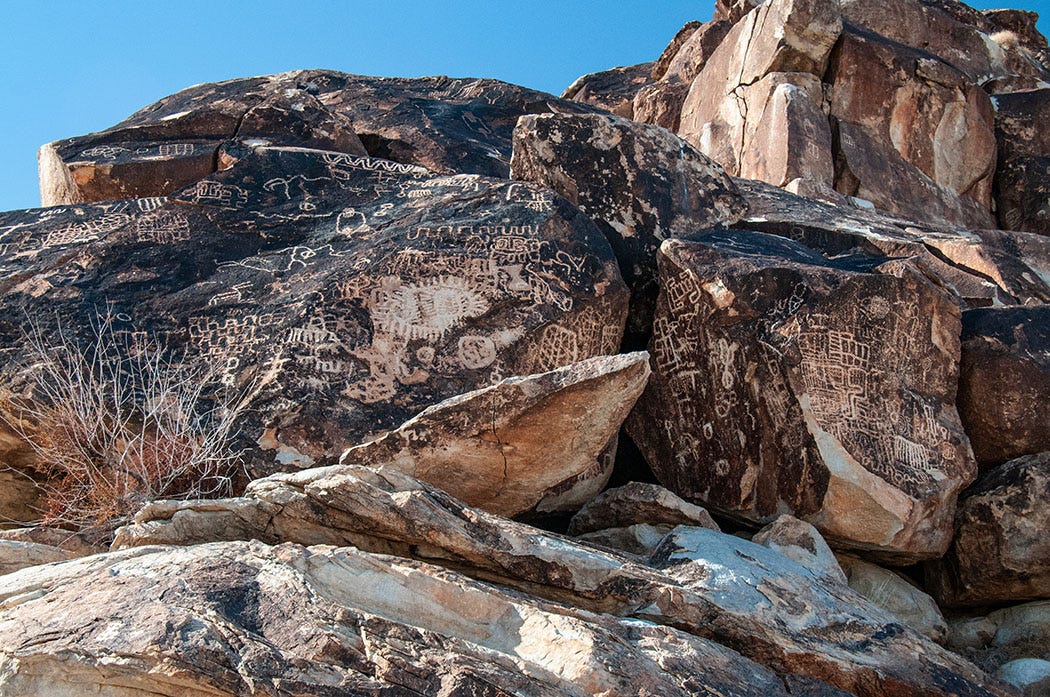



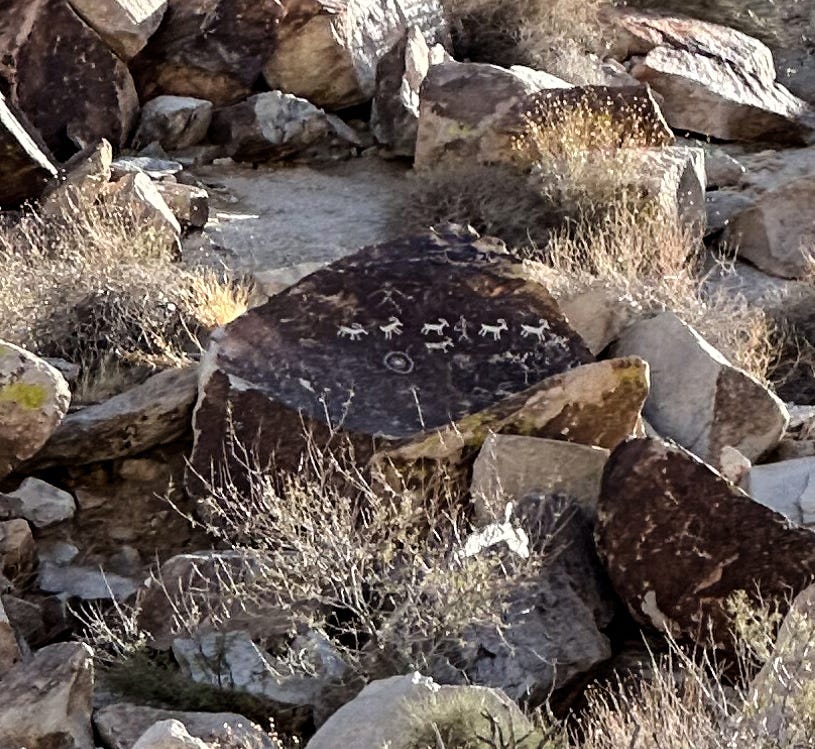
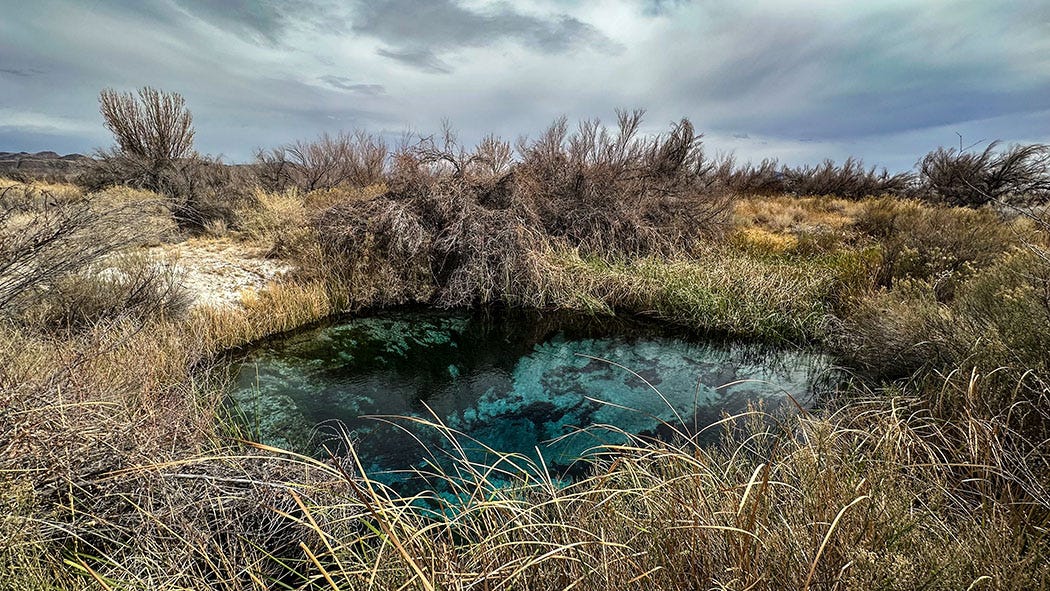
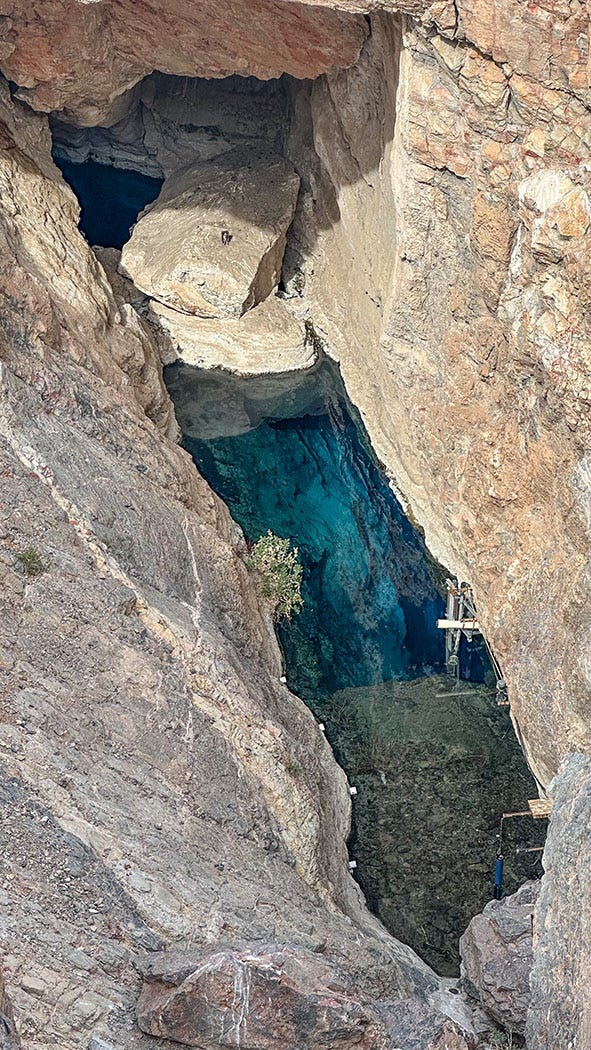




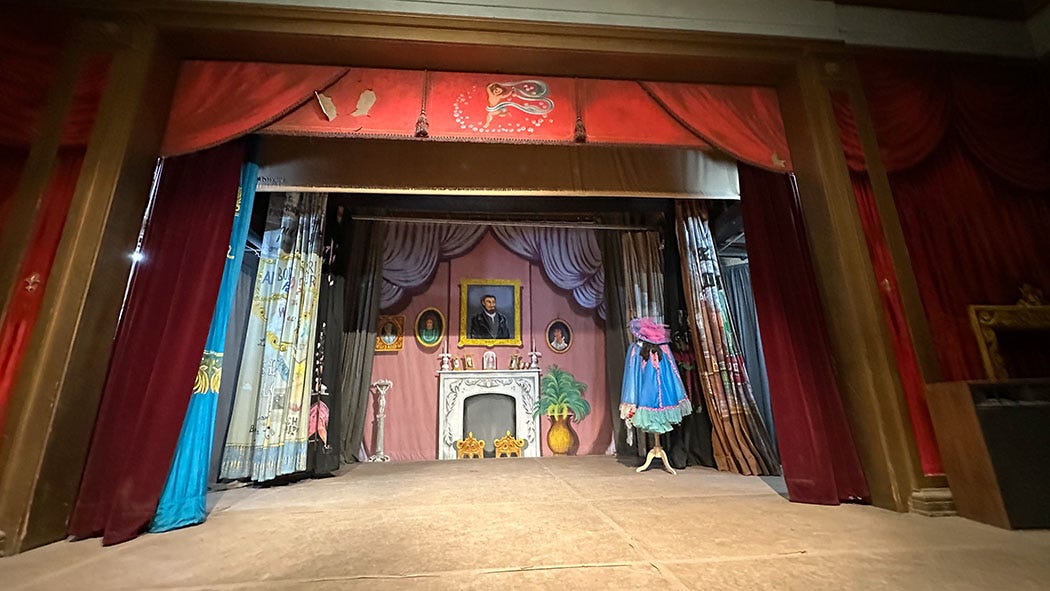
Very interesting read especially at the end where you talk about Marta Becket and her opera house. I love the photos of the interior! It is certainly a contrast with the rock art which is also amazing. Thanks for sharing your travels!
The way you've connected the pecked-in petroglyphs of long ago with Marta's murals is marvelous and profound. Ancient graffiti is elevated by their creators' vision and genius, as with Marta's genius vision of performing to a full house. "In her way, Marta was a shaman..."
Yes, yes she was.